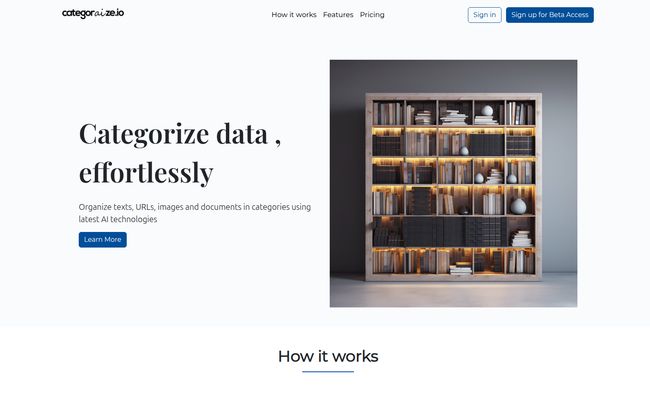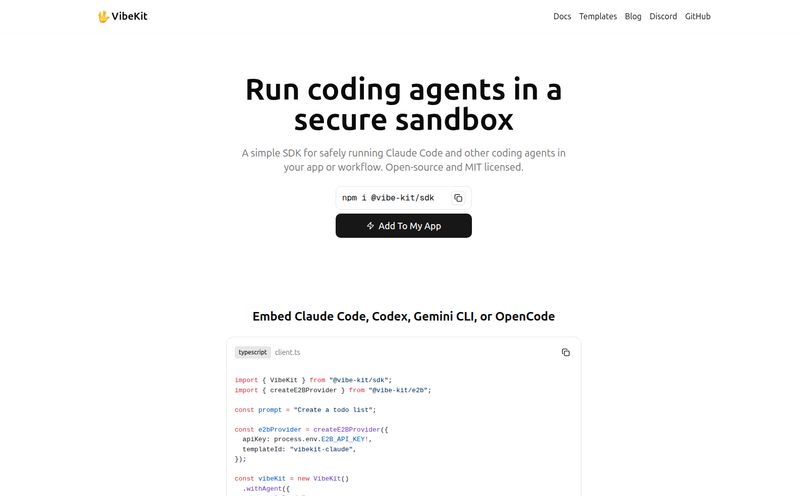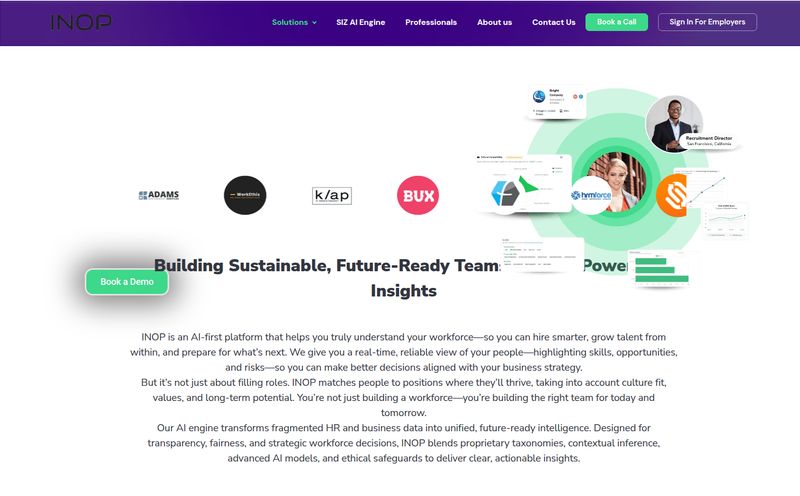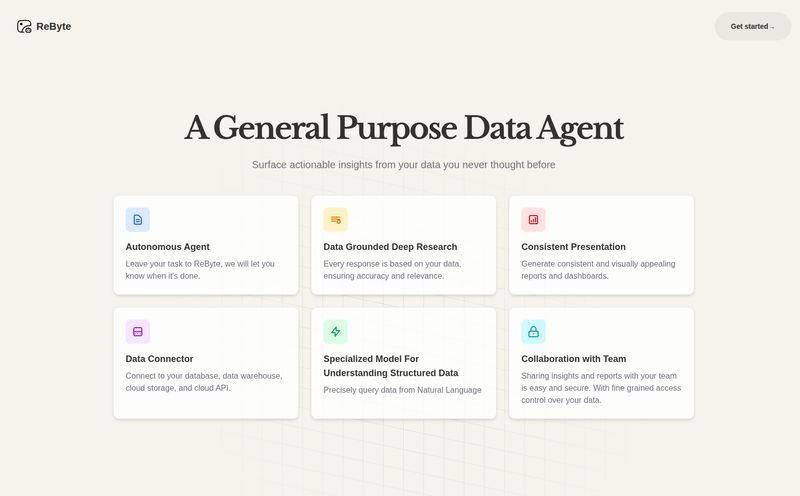If your digital life is anything like mine, it’s a sprawling, chaotic mess. I've got folders full of client assets, a decade of blog post ideas in a dozen different apps, and a downloads folder that I’m pretty sure has achieved sentience. For years, the dream has been a magic button to sort it all out. We've had tags, we've had folders, we've had complex filing systems that last about a week. It’s exhausting.
So, when a tool like categorAIze.io lands on my radar, my professional curiosity gets a serious jolt. The tagline is simple: "Categorize data, effortlessly." Effortlessly? We'll see about that. The promise is to use the latest AI—the same large language model (LLM) tech that’s been writing poems and code—to automatically organize texts, URLs, images, and documents. It’s like hiring a tiny, hyper-efficient librarian to live in your computer.
But as someone who's seen a thousand 'game-changing' SaaS tools come and go, I'm naturally skeptical. Is this another overhyped gadget, or is it the real deal? Let's take a look.

Visit categorAIze.io
What Is This categorAIze.io Thing Anyway?
Think of it like this. You have a giant pile of books, articles, and photos dumped on the floor. Your job is to put them on a bookshelf. You could spend all weekend reading the back of every book and looking at every photo to decide if it belongs in 'Fiction', 'History', or 'Vacation Snaps'. Or... you could have a super-smart assistant who can glance at each item and instantly know where it goes. That’s categorAIze.io.
It’s an AI-powered platform designed to take your digital 'stuff'—be it product descriptions, user feedback, research papers, or a folder of stock images—and sort it into a neat, hierarchical structure. The cool part is that you can either give it your own predefined categories (like a good old-fashioned filing system) or you can throw your data at it and let the AI figure out the categories on its own. Now that got my attention.
How Does It Actually Work?
The process seems refreshingly straightforward, which I appreciate. No 50-step onboarding process here. It boils down to a few key actions:
- Define & Upload: You start by either giving the system your list of categories—you can even create sub-categories for a nice, deep structure—or you can just skip this and move on to step two. Then you upload your items: text files, URLs, images... you get the idea.
- Let the AI Cook: This is where the magic is supposed to happen. The LLM gets to work, analyzing the content and visuals of each item. It then assigns it to the most appropriate category you've provided. Or, if you went the brave route, it starts creating a logical category structure for you based on what it sees.
- Access & Use: Once everything's sorted, you can access it through their web interface, pull the data via an API to use in your own apps, or even request specific plugins for your workflow.
It’s a simple loop, but the power is in that second step. The ability to just dump a CSV file and have it come back organized is a huge time-saver, at least in theory.
The Features That Made Me Look Twice
I’ve seen a lot of AI tools, and many are just a thin wrapper around an OpenAI API call. I was looking for something more, and a few features here do stand out.
Taming the Chaos with Custom and AI-Generated Categories
This flexibility is probably the biggest selling point. I’ve worked on e-commerce projects where the category structure is rigid and non-negotiable. For that, being able to define a fixed hierarchy and have the AI sort new products into it is fantastic. But I've also done market research where we didn't know what the key themes would be. The idea of feeding thousands of customer reviews to the AI and having it generate the main topics of complaint or praise... that's seriously powerful stuff. It shifts the tool from a simple sorter to a discovery engine.
No PhD in Data Science Required (No Training Data!)
This is a big one. So many machine learning tools require you to 'train' the model. You have to feed it hundreds of examples and manually correct it until it learns your needs. It's a massive upfront investment of time. CategorAIze.io claims you don’t need any of that. Because it's using pre-trained LLMs, it already has a broad understanding of language and context. You can just throw your data at it from day one. That lowers the barrier to entry significantly.
More Than Just Text: Image and URL Categorization
The platform isn’t just a text analyzer. It can 'look' at images or crawl a URL for its content and categorize based on that. For anyone managing digital assets, from social media managers to stock photo sites, this is a huge deal. Imagine uploading 5,000 new images and having them automatically sorted into folders like 'Nature Landscapes', 'Urban Architecture', and 'People Working'. Yes please.
Let's Talk Turkey: The Pricing Model
Alright, this is where things get interesting, and maybe a little complicated. The pricing isn’t a simple flat monthly fee. It's broken into two parts: AI usage and data storage. I actually prefer this kind of transparency, but you need to understand it.
The Pay-as-you-go AI Calls
You're essentially paying for the AI's 'thinking time'. This is metered in 'tokens' (bits of words) and by the image. They offer two tiers of AI models:
- Basic LLM: Cheaper, at $0.003 per 1000 tokens. Good for straightforward text categorization. It can't process images.
- Cutting-edge LLM: More expensive, at $0.06 per 1000 tokens and $0.006 per image. This is the more powerful model you'd use for nuanced tasks, image analysis, or when you need the highest accuracy.
You start with a refundable $5 credit to test the waters, which is a nice touch. The key is that more usage means more cost. This isn’t an all-you-can-eat buffet. It's an a la carte menu, which can be great for small projects but could get pricey if you're analyzing millions of items a day.
The Monthly Storage Plans
Once your data is categorized, it needs to live somewhere. This is where the more traditional monthly subscription comes in. The plans are pretty clear:
| Plan | Cost | Details |
|---|---|---|
| Free | $0/mo | Up to 24-hour storage. You must export your data. |
| Basic Storage | $9.95/mo | 750 items, 1 GB of data |
| Standard Storage | $49.95/mo | 5,000 items, 10 GB of data |
| Pro Storage | $149.95/mo | 20,000 items, 40 GB of data |
They also mention Enterprise Solutions for custom needs, which is standard for a B2B tool.
My Take on the Cost
So is it a good deal? My gut says: it depends entirely on your use case. The Free plan is perfect for a one-off project where you just need to sort a batch of data and export it. For ongoing work, you have to do the math. Calculate the value of the time you'd save. If manually sorting 5,000 products takes you 40 hours of tedious work, is paying $50 for storage and another chunk for the AI calls worth it? Almost certainly. The pay-as-you-go model for the AI is the part that requires careful management, but it's also fair—you're only paying for what you actually use.
Who Is This Tool Really For?
I don't think this is a tool for the casual user trying to organize their family photos (though you could!). I see its real value in a few key areas:
- E-commerce Managers: Automating the categorization of new SKUs, especially from multiple vendors with inconsistent data.
- Content Curators & Marketers: Sorting articles, research, and user-generated content into topic clusters for better SEO and content strategy.
- Researchers & Academics: Analyzing qualitative data from surveys, interviews, or literature reviews to identify emergent themes.
- Digital Asset Managers: Organizing massive libraries of stock photos, videos, and design assets.
Essentially, if your job involves a high volume of incoming, unstructured data that needs to be sorted, this platform should be on your list to check out.
A Few Parting Thoughts
Look, no tool is perfect. The main drawback I see with categorAIze.io is the potential for costs to creep up if you're not paying attention to your AI usage. That pay-as-you-go model is a double-edged sword; it offers great flexibility but demands responsibility. You'll need to be mindful of which AI model you're using and for what. The monthly fee for just storing the data also adds to the total cost of ownership, unlike a one-time software purchase.
But on the flip side, the amount of time and manual effort this could save is immense. The drudgery of sorting and tagging is one of the biggest bottlenecks in any data-heavy workflow. Automating that away with a reasonably smart AI is an incredibly attractive proposition. The fact that it requires no prior training and handles various data types makes it a very compelling package. It’s one of the more practical and focused applications of LLM tech I’ve seen in a while.
Frequently Asked Questions (FAQ)
Do I need to be a developer to use categorAIze.io?
Not at all. While they offer an API for developers to integrate the service into their own applications, the platform also has a straightforward graphical user interface (GUI). You can upload files like CSVs and manage your categories directly in your web browser without writing a single line of code.
Can it handle my company's super-specific categories?
Yes. That's one of its core strengths. You can define your own custom categories, no matter how niche. Whether it's 'Industrial Widget Type A-3' or 'Customer Feedback - Shipping Complaints - West Coast', you create the hierarchy, and the AI will use its contextual understanding to sort your items into your specific structure.
Is the free storage plan actually useful?
It's very useful for specific tasks. If you have a one-time need to categorize a large dataset—for example, analyzing a customer survey—the free plan is perfect. You can upload your data, let the AI categorize it, and then export the organized results within 24 hours. It's not designed for ongoing data management, but it's a fantastic way to test the platform or handle singular projects.
What exactly is a 'token' and why am I paying for it?
In the world of Large Language Models, a token is a piece of a word. Roughly, 1,000 tokens is about 750 words. AI models 'read' and 'write' in tokens, not words or characters. You pay for tokens because it's a direct measure of how much computational work the AI is doing to analyze your text. The more text the AI has to process, the more tokens it consumes.
Can the AI make mistakes?
Absolutely. While modern LLMs are incredibly advanced, they are not infallible. The accuracy can depend on the quality of your data and the clarity of your categories. It's always a good practice to review a sample of the AI's work, especially early on. However, its accuracy is generally far higher and infinitely faster than a tired human on a Friday afternoon.
So, Is It Time to Hire the AI Librarian?
My final verdict? I'm cautiously optimistic. CategorAIze.io isn't a magic wand that will instantly solve every data problem. But it is a sharp, powerful, and surprisingly accessible tool for a very specific, and very common, pain point. If you find yourself drowning in unstructured data, it’s well worth taking advantage of their free tier and refundable credit to see if it can build you a better bookshelf. It just might be the smartest librarian you’ve ever hired.



